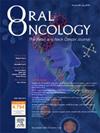Achieving negative superficial resection margins with NBI and white light in carcinoma oral cavity: Could it be a norm?
IF 3.9
2区 医学
Q1 DENTISTRY, ORAL SURGERY & MEDICINE
引用次数: 0
Abstract
Introduction
In India, oral cavity cancer rates are the highest, largely due to tobacco and areca nut use. The primary goal of oncologic surgery is complete tumor resection with adequate margins, yet no accepted guidelines exist margin identification. NBI enhances mucosal lesion detection and may improve margin assessment in OSCC.
Aims
This study aims to evaluate the proportion of negative superficial resection margins using NBI and to compare these results with margins assessed using white light (WL) examination.
Materials and Methods
The study at AIIMS, Rishikesh, included 38 patients with T1-T3 biopsy-proven OSCC. Surgical margins were marked using WL and NBI. Histopathology classified margins as clear (>5mm), close (1–5 mm), or involved. Sensitivity, specificity, and predictive values of NBI were calculated.
Results
The average NBI examination duration was 227 s. Negative margins were achieved in 68.42 % (>5mm) and 78.94 % (>3mm) of NBI cases, compared to 71.05 % and 84.21 % for WL. NBI had a sensitivity of 12.50 %, specificity of 96.67 %, and overall accuracy of 78.95 %.
Discussion
NBI showed high specificity but low sensitivity. This could be due to the smaller number of patients in NBI positive group. In the present study, the single positive margin identified with NBI could also have been detected with the combined approach of white light and palpation, ensuring that no positive margins were missed.
Conclusion
NBI can complement WL for margin assessment in oral SCC but requires a long learning curve and a dedicated team. Integrating NBI into standard protocols could improve surgical outcomes and reduce recurrence.
在口腔癌中使用 NBI 和白光可使浅表切除边缘呈阴性:这可能是一种常态吗?
导言在印度,口腔癌的发病率是最高的,这主要是由于烟草和槟榔的使用。肿瘤手术的首要目标是完整切除肿瘤并保留足够的边缘,但目前尚无公认的边缘识别指南。本研究旨在评估使用 NBI 进行表层切除边缘阴性的比例,并将这些结果与使用白光 (WL) 检查评估的边缘进行比较。使用 WL 和 NBI 对手术边缘进行标记。组织病理学将边缘分为清晰(5 毫米)、接近(1-5 毫米)或受累。68.42%(5 毫米)和 78.94%(3 毫米)的 NBI 病例边缘为阴性,而 WL 病例边缘为阴性的比例分别为 71.05% 和 84.21%。NBI 的灵敏度为 12.50%,特异性为 96.67%,总体准确率为 78.95%。这可能是由于 NBI 阳性组的患者人数较少。在本研究中,通过 NBI 发现的单个阳性边缘也可以通过白光和触诊联合方法检测到,从而确保不会漏掉任何阳性边缘。结论 NBI 可以补充 WL 对口腔 SCC 边缘的评估,但需要较长的学习曲线和专门的团队。将 NBI 纳入标准方案可提高手术效果并减少复发。
本文章由计算机程序翻译,如有差异,请以英文原文为准。
求助全文
约1分钟内获得全文
求助全文
来源期刊

Oral oncology
医学-牙科与口腔外科
CiteScore
8.70
自引率
10.40%
发文量
505
审稿时长
20 days
期刊介绍:
Oral Oncology is an international interdisciplinary journal which publishes high quality original research, clinical trials and review articles, editorials, and commentaries relating to the etiopathogenesis, epidemiology, prevention, clinical features, diagnosis, treatment and management of patients with neoplasms in the head and neck.
Oral Oncology is of interest to head and neck surgeons, radiation and medical oncologists, maxillo-facial surgeons, oto-rhino-laryngologists, plastic surgeons, pathologists, scientists, oral medical specialists, special care dentists, dental care professionals, general dental practitioners, public health physicians, palliative care physicians, nurses, radiologists, radiographers, dieticians, occupational therapists, speech and language therapists, nutritionists, clinical and health psychologists and counselors, professionals in end of life care, as well as others interested in these fields.
 求助内容:
求助内容: 应助结果提醒方式:
应助结果提醒方式:


